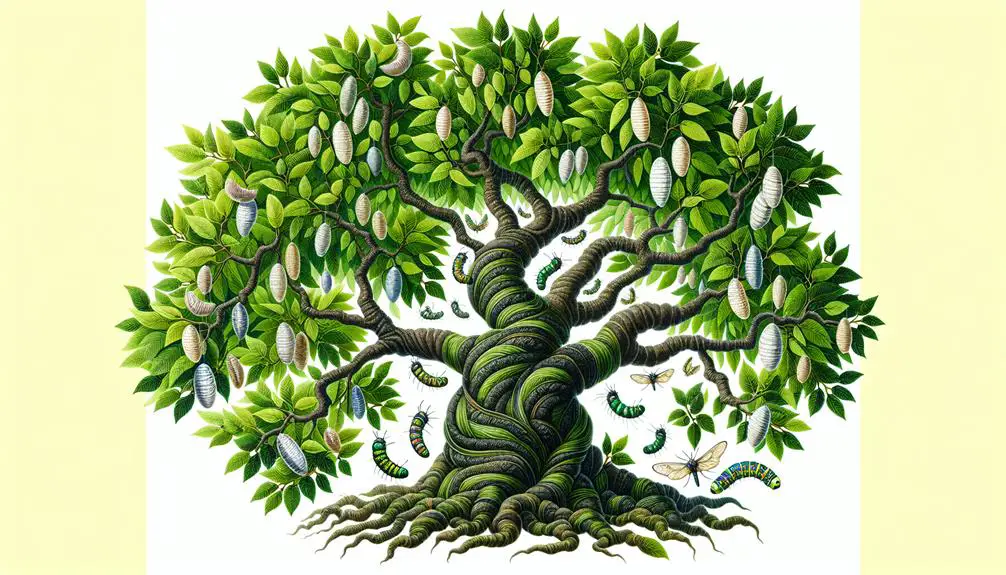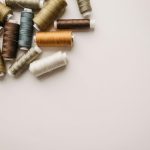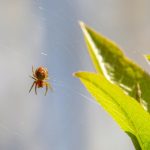I'd say the main source of silk fiber is cultivated silkworms. They're the ones responsible for producing most of the silk you see. On the other hand, wild silk comes from naturally occurring silkworms. It's fascinating how these little creatures create such a luxurious material, isn't it? If you're curious about the process and why silk has become so popular, there's more to discover about silk production, its various applications, and even its impact on the environment. There's a whole world of silk waiting to be explored!
Table of Contents
Key Takeaways
- Cultivated silk from silkworms is the main source.
- Wild silk harvested from naturally occurring silkworms is another source.
- Cultivated silk requires intensive farming practices.
- Wild silk has a lower environmental impact compared to cultivated silk.
- Balancing demand for silk with sustainable practices is crucial.
Silk Fiber Production Process
In producing silk fiber, we start with the cultivation of silkworms, particularly the mulberry silkworm (Bombyx mori), which are the primary source of this luxurious material. These silkworms spin cocoons made of silk fibers through a process known as sericulture. After the cocoons are harvested, they undergo a degumming treatment to remove the sericin coating, which results in enhancing the properties of the silk fibers.
Once the degumming process is complete, the silk fibers are extracted from the cocoons. Techniques like reeling and spinning are employed to create continuous silk filaments. These filaments are then woven together to form the delicate and exquisite silk fabric that's highly sought after for various luxury products.
The silk fiber production process involves several stages, including harvesting, degumming, spinning, and weaving. Each step is vital in ensuring the high quality and durability of the final silk fabric, making it a prized material in the fashion and textile industries.
Silkworm Larvae and Silk Fiber
So, let's talk about silkworm larvae and silk fiber. These little creatures play a big role in the silk production process.
From their life cycle to the spinning of the fibers, there's a fascinating journey behind each silky thread.
Silkworm Life Cycle
As silkworms progress through their life cycle, they undergo four distinct stages, including the larval stage where silk fibers are secreted to form protective cocoons. The process begins with eggs hatching into larvae, also known as caterpillars, that voraciously feed on mulberry leaves. During this stage, silkworms produce silk fibers from specialized salivary glands to create their cocoons.
Once the larvae have stored enough nutrients, they enter the pupal stage, where they undergo metamorphosis inside the cocoon. Eventually, the adult moth emerges from the cocoon to mate and lay eggs, continuing the life cycle. Sericulture, the practice of cultivating silkworms for silk production, plays an essential role in harvesting these valuable silk fibers for various uses.
Silk Production Process
Silkworm larvae, through a fascinating process, produce silk fiber by secreting fibroin protein to form their protective cocoons. In the silk production process, sericulture plays a crucial role in rearing mulberry silkworms, the primary source of high-quality silk fiber. Harvesting cocoons is a meticulous task where the cocoons are collected and subjected to degumming to extract the silk fibers. These fibers are then spun into yarn, ready to be woven into luxurious fabrics. The entire process from silkworm to silk fiber is a labor-intensive but rewarding endeavor that results in the exquisite material highly valued for its smooth texture and sheen.
| Silk Production | Process Description |
|---|---|
| Sericulture | Rearing silkworms for silk production |
| Mulberry Silkworms | Primary source of silk fiber |
| Harvesting Cocoons | Collecting cocoons for silk extraction |
| Spinning Yarn | Turning silk fibers into yarn |
Fiber Spinning Technique
During the fascinating process of silk production, the spinning of silk fiber by silkworm larvae involves extruding fibroin protein through specialized glands. The spinnerets on the silkworm's head play an essential role in this process, creating a continuous silk filament as the larvae move in a figure-eight pattern.
The quality and properties of the silk fiber produced are influenced by factors such as the spinning speed and movement of the silkworm larvae. Understanding how these elements impact silk fiber spinning is vital for ensuring the production of high-quality silk with desirable characteristics.
It's truly remarkable how the intricate movements of the silkworm larvae contribute to the creation of the luxurious silk fibers we admire.
Fibroin Protein Secretion Mechanism
So, let's talk about how silkworms actually make silk. It's pretty fascinating!
The way these little guys produce fibroin, the key protein for silk, is quite a remarkable natural process.
Let's dig into the details of this fibroin secretion mechanism.
Silk Protein Synthesis
In the intricate process of silk production, a key step involves the secretion of fibroin protein by specific insect larvae. When it comes to silk protein synthesis:
- Silk Fibroin: This protein is the primary component of silk fibers, contributing to their strength and resilience.
- Silkworm Role: Silkworms play an essential part in silk protein synthesis by secreting fibroin during the spinning process.
- Structural Importance: Silk fibroin acts as a structural protein, imparting durability to silk fibers.
- Production Enhancement: Understanding the mechanism of silk protein synthesis is important for improving silk production and ensuring high-quality silk products.
Silk protein synthesis, particularly the secretion of fibroin by silkworms, is fundamental to the exquisite nature of silk fibers.
Secretion Mechanism Details
The secretion mechanism detailing how fibroin protein is released from the silk glands of silkworm larvae plays an important role in the creation of silk fibers.
When silkworms go through metamorphosis, their silk glands secrete a concentrated solution containing fibroin, a key component for silk fiber formation. This solution is carefully extruded through spinnerets, tiny openings on the silkworm's head, allowing it to solidify into silk fibers upon contact with the air.
The fibroin solution contains essential proteins and substances necessary for the formation of strong and resilient silk fibers. Understanding this intricate secretion mechanism is significant as it marks the initial step in the production of silk fibers from silkworm cocoons, highlighting the natural process that yields one of the most coveted materials in the world.
Cocoon Formation Process
Spinning silk threads in a figure-eight pattern, silkworm larvae create their protective cocoons during the cocoon formation process. It's fascinating to witness how these tiny creatures meticulously weave their homes using silk threads.
Here are some key points to understand the cocoon formation process:
- Silk Threads: The silkworm larvae produce silk threads by secreting fibroin, a protein that solidifies into silk fibers for constructing the cocoon.
- Sericin Binding: To hold the silk fibers together, the silkworm secretes sericin, a sticky protein that acts as a natural adhesive during cocoon formation.
- Pupation Stage: The cocoon serves as a shelter for the silkworm during the pupation stage, safeguarding it while it undergoes metamorphosis.
- Harvesting Silk Fibers: After the pupation is complete, silk cocoons are carefully collected and processed to extract the valuable silk fibers for various applications.
The intricacies of the cocoon formation process highlight the remarkable abilities of silkworms to produce the luxurious silk fibers we appreciate.
Unraveling Silk Threads From Cocoons
Upon gently boiling silk cocoons, the sericin protein softens, allowing for the delicate unraveling of the silk threads. This process involves carefully unwinding the silk filaments from the cocoons without causing them to break. As the silk threads are unraveled, they're then twisted together to create yarn, which serves as the foundation for various silk products.
It's important to execute this process with skill and precision to maintain the quality and strength of the silk fibers. Selecting the right silk cocoons for unraveling is essential to obtain long, continuous silk threads that are suitable for weaving into textiles. The transformation from silk cocoons to yarn showcases the intricate nature of silk production and the craftsmanship involved in turning raw silk filaments into versatile materials for a wide range of products.
Silk Fiber Processing Techniques
Extracting silk fibers from cocoons involves specialized techniques such as degumming to remove the sericin coating, essential for producing high-quality silk yarns. When it comes to silk fiber processing techniques, a few key methods stand out:
- Degumming: This process is essential as it eliminates the sericin coating, revealing the fibroin core of the silk fiber.
- Sericulture: Cultivating silkworms for silk production is at the heart of the industry, with the Bombyx mori species' cocoons being the primary source of silk.
- Different Spinning Techniques: Dry-spinning, wet-spinning, and electrospinning are employed to create various types of silk yarns, each with unique properties and applications.
- Analysis Techniques: Advanced methods like FTIR, XRD, NMR, and Raman spectroscopy are utilized to examine the micro and nanostructure of silk fibers, aiding in quality control and innovation in silk processing.
Understanding these silk fiber processing techniques is essential for mastering the art of silk production and creating high-quality silk products.
Properties of Natural Silk Fiber
Natural silk fiber, sourced primarily from the cocoons of silkworms, possesses unique properties that set it apart from other fibers in the textile industry. Silk fibers are protein-based and mainly composed of fibroin, providing both strength and luster. These fibers exhibit high tensile strength, softness, and a shimmering appearance due to their triangular prism-like structure. One remarkable feature of natural silk is its biodegradability, making it a more environmentally friendly choice compared to synthetic fibers. The production of natural silk involves intricate processes like sericulture, cocoon harvesting, and silk reeling to obtain the valuable raw material.
| Properties of Natural Silk Fiber | |
|---|---|
| High Tensile Strength | Softness |
| Shimmering Appearance | Biodegradability |
Silk's blend of strength, softness, and biodegradability makes it a sought-after material in various textile applications.
Textile Applications of Silk Fiber
Silk fiber finds widespread use in various textile applications due to its exceptional properties and versatility in creating luxurious and durable fabrics. Here are some key textile applications of silk fiber:
- Silk Textiles: Silk is commonly used in producing a wide range of textiles such as sarees, scarves, ties, and high-end fashion garments due to its softness and lustrous appearance.
- Medical Sutures: Silk fibers are utilized in medical and surgical sutures because of their biocompatibility, strength, and smooth texture, making them ideal for biomedical materials.
- Industrial Applications: In the industrial sector, silk fibers are valuable for products like parachutes and fishing lines due to their durability and impressive tensile strength.
- Textile Industry: Silk's ability to be dyed in various colors adds versatility to the textile industry, allowing for the creation of vibrant and attractive fabrics that maintain their luxurious feel.
Silk Fiber in Clothing Industry
I love how silk plays a major role in the fashion world, bringing elegance and luxury to clothing.
The unique properties of silk fabric, like its softness and strength, make it a top choice for high-end garments.
Learning about the intricate production process of silk, from cocoon to yarn, adds a fascinating layer to appreciating its presence in the clothing industry.
Silk in Fashion
Among luxurious fabrics sought after in the fashion world, silk fiber stands out for its unparalleled softness and natural sheen. When it comes to silk in fashion, there are a few key points to note:
- Silk garments: Silk is a staple in high-end fashion, commonly used in garments like scarves, shirts, lingerie, and eveningwear.
- Luxurious feel: The smooth texture of silk provides a luxurious feel against the skin, making it a preferred choice for those looking for comfort and elegance.
- Versatile accessories: Silk fiber isn't limited to clothing; it's also utilized in accessories such as ties, adding a touch of sophistication to any outfit.
- Natural sheen: The inherent sheen of silk fabric enhances the overall appeal of garments and accessories, giving them a classy and polished look.
Silk Fabric Properties
With its remarkable strength, lustrous appearance, and soft texture, silk fabric has become a highly coveted material in the clothing industry.
Silk fibers, being protein-based, possess exceptional tensile strength, making them perfect for creating luxurious apparel and accessories that stand the test of time.
One of the standout features of silk fabric is its excellent draping qualities, allowing it to flow elegantly and conform to the body's shape, enhancing the overall look of high-end fashion garments.
From sarees to scarves and ties, silk textiles exude sophistication and charm, making them a popular choice among designers and consumers looking for quality and style in their clothing.
Silk Production Process
Silk production in the clothing industry starts with harvesting silkworm cocoons, an essential step in obtaining the coveted silk fiber. Here's a breakdown of the silk production process:
- Harvesting: Silkworm cocoons are carefully collected from silk farms.
- Sericin Removal: The cocoons undergo a degumming process to eliminate the sticky sericin protein.
- Reeling Silk Filaments: The extracted silk fibers are then reeled from the cocoons.
- Silk Yarn Production: These silk filaments are spun into yarn, which is later woven into luxurious fabrics for clothing.
This intricate process, from the humble silkworm to the creation of exquisite silk yarn and fabrics, is what gives silk its reputation for being one of the most luxurious materials in the fashion industry.
Silk Fiber in Medical Applications
In the domain of medical applications, the versatile silk fiber has garnered attention for its exceptional biocompatibility and strength, making it a valuable asset in tissue engineering and wound healing.
Silk fibers are utilized in creating tissue scaffolds, providing a supportive structure for cells to grow and regenerate damaged tissues. Additionally, researchers are exploring the potential of silk fiber composites for nerve regeneration, aiming to develop innovative solutions for nerve injuries.
In the field of wound healing, silk fibers play an important role in promoting healing and reducing scarring due to their natural properties. Furthermore, the use of silk particles and fibers in drug delivery systems offers a controlled release of medications, impacting treatment efficacy.
The combination of silk fiber with biopolymers allows for tailored degradation rates, enhancing the versatility of these materials in various biomedical applications. Recombinant silk fibers, like Biosteel®, hold promise for applications in suture materials, particularly in delicate procedures such as microsurgery.
Environmental Impact of Silk Production
Considering the environmental impact of silk production, it's essential to acknowledge the various factors that contribute to its sustainability and potential consequences.
- Cultivated silk production often involves significant land use for mulberry cultivation and silkworm rearing, impacting natural habitats and biodiversity.
- Water consumption in silk production processes, such as reeling and dyeing, can lead to water scarcity and pollution if not managed properly.
- Wild silk, harvested from naturally occurring silkworms, has a lower environmental impact as it doesn't require intensive farming practices like cultivated silk.
- Balancing the demand for silk with sustainable practices is vital to minimize the environmental footprint of silk production.
Understanding the differences between cultivated and wild silk production methods highlights the importance of adopting sustainable practices in the silk industry. By considering factors like land use and water consumption, we can work towards reducing the environmental impact of silk production while meeting the global demand for this luxurious fabric.
Sustainable Practices in Silk Cultivation
Implementing sustainable practices in silk cultivation involves organic mulberry farming without the use of pesticides or chemicals. This method ensures that the silk production process is environmentally friendly and promotes the health of the silkworms and the surrounding ecosystem. Integrated pest management techniques play a vital role in reducing the reliance on harmful chemicals, thereby minimizing the impact on the environment. Water conservation methods are also essential in sustainable silk cultivation, as they help reduce water usage and protect local water sources.
Recycling silkworm excrement as organic fertilizer is another sustainable practice that enhances the soil quality and reduces waste in silk farming. Additionally, utilizing solar energy for powering silk production processes and incorporating eco-friendly packaging materials helps decrease the carbon footprint of the entire supply chain. By embracing these sustainable silk cultivation practices, we can contribute to a more environmentally conscious and responsible silk industry that prioritizes both quality and sustainability.
Frequently Asked Questions
What Is the Main Source of Silk Fibers?
The main source of silk fibers is the cocoon of the silkworm. Through sericulture, we cultivate silkworms to obtain these fibers. Mulberry silk is the most common type. Wild silk, like tussar silk, also comes from non-domesticated silkworms.
What Is the Best Source of Silk?
The best source of silk is the cocoon of the domesticated silkworm species Bombyx mori. It produces high-quality silk known for its fine texture, strength, and luster. This silk is widely used due to its superior qualities.
Where Does Most Silk Come From?
Most silk comes from Asia, with China being the primary source, producing around 146,000 metric tonnes annually. India, Uzbekistan, and Thailand also contribute significantly. Chinese silk prices range between $50 and $55 per kilogram.
What Is the Main Material in Silk?
The main material in silk is fibroin, a protein that silkworms secrete to form their cocoons. It provides strength and resilience to the fibers. Fibroin's unique properties, like high tensile strength and smooth texture, make silk valuable.
- Jaclyn Smith Fabric Coconut: a Review of This Rayon/Polyester Blend - June 29, 2025
- Jaclyn Smith Fabric Coconut: a Review of This Rayon/Polyester Blend - June 29, 2025
- How to Get Coconut Oil off Fabric Without Washing - June 29, 2025






